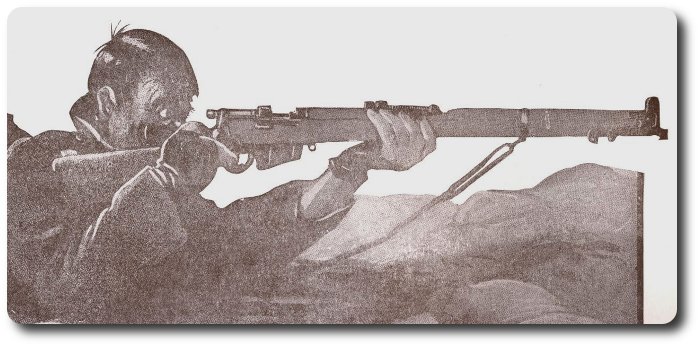Topic: CEF

"Watch me make a fire-bucket of 'is helmet," (cropped)
by Bruce Bairnsfather, from Fragments from France, (Putnams, 1917).
Snipers of the 8th Canadian Infantry Battalion
Canada in Flanders, by Sir Max Aitken, M. P., 1916
 July was a sniper's month. True, every month is a sniper's month; the great game of sniping never wanes, but the inactivity in other methods of fighting left the field entirely free for the sharpshooter in July.
July was a sniper's month. True, every month is a sniper's month; the great game of sniping never wanes, but the inactivity in other methods of fighting left the field entirely free for the sharpshooter in July.
It was during the fighting at Givenchy in June, 1915, that four snipers of the 8th Canadian Battalion (Winnipeg Rifles) agreed to record their professional achievements from that time forward on the wood of their rifles.
Private Ballendine, one of the four, is from Battleford. He is tall and loosely built. In his swarthy cheeks, black eyes, and straight black hair, he shows his right to claim Canadian citizenship, by many generations of black-haired, sniping ancestors. He learned to handle a rifle with some degree of skill at the age of ten years, and he has been shooting ever since. At the present time he carries thirty-six notches on the butt of his rifle. Each notch stands for a dead German—to the best of Ballendine's belief. One notch, cut longer and deeper into the brown wood than the others, means an officer.
To date, Private Smith, of Roblin, Manitoba, has scratched the wood of his rifle only fourteen times but he is a good shot, has faith in his weapon, and looks hopefully to the future.
Private McDonald, of Port Arthur, displays no unseemly elation over his score of twenty-six.
Private Patrick Riel makes a strong appeal to the imagination , though his tally is less than McDonald's by two or three. He is a descendant of the late Louis Riel, and when he enlisted in the 90th Winnipeg Rifles at the outbreak of the war, and was told by one of his officers that his regiment had done battle against his cousin Louis at Fish Creek and Batoche, he showed only a mild interest in this trick of Time. Riel, like McDonald, comes from Port Arthur way. Before the war he earned his daily bacon and tobacco as a foreman of lumber-jacks on the Kaministiquia River.
The weapons used by these four snipers are Ross rifles, remodelled to suit their peculiar and particular needs. Each is mounted with a telescopic sight, and from beneath the barrel of each much of the wood of the casing has been cut away. The men do their work by day, as the telescopic sight is not good for shooting in a poor light. They are excused all fatigues while in the trenches and go about their grim tasks without hint or hindrance from their superiors. They choose their own positions from which to observe the enemy and to fire upon him, sometimes in leafy covers behind our front-line trench, sometimes behind our parapet. Very little of their work is done in the "No Man's Land'' between the hostile lines, for there danger from the enemy is augmented by the chance of a shot from some zealous but mistaken comrade. the mention of "No Man's Land" reminds me that, on the Canadian front, this desolate and perilous strip of land is now called "Canada." The idea is that our patrols have the upper hand here, night and day—that we govern the region, though we have not stationed any Governor ot Resident magistrate there as yet.

The Snipers
While working from names only, especially in cases of common surnames like "Smith," it can be a challenge to positively identify soldiers in the Library and Archives Canada database of Soldiers of the First World War. As best as can be determined with the available information, including the battalion's 1915 nominal roll, it is possible that these are the 8th Battalion snipers:
- 81039 John Ballendine
- 81820, Frederick Arnold Smith; (CVWM entry)
- 81631, Donald Alexander McDonald
- 1295, Patrick Riel; (CVWM entry)

